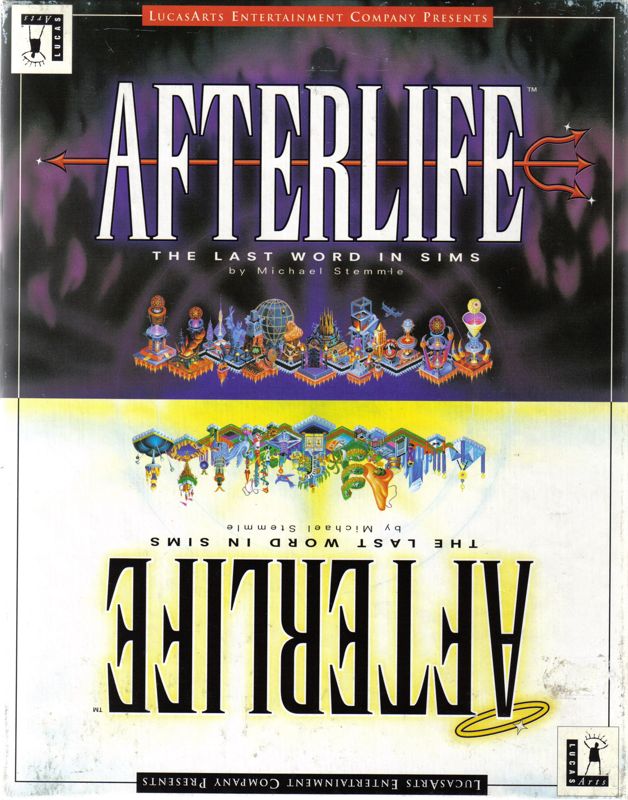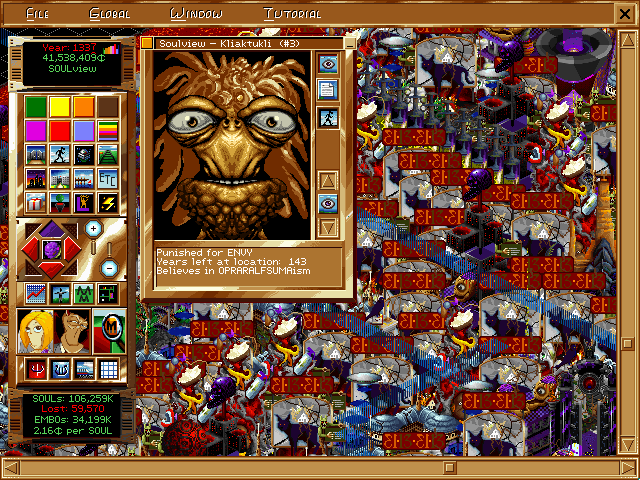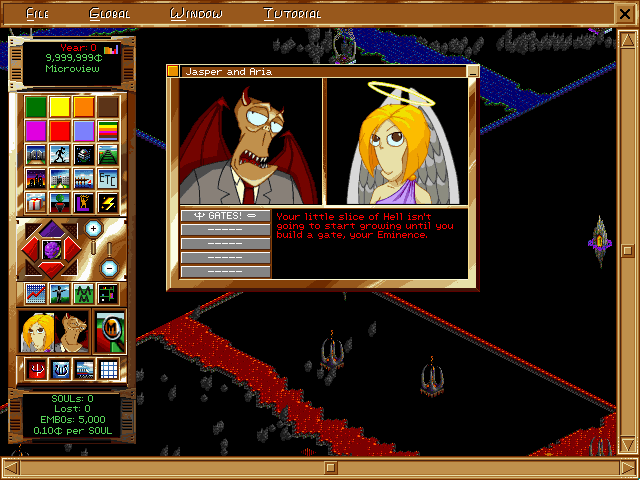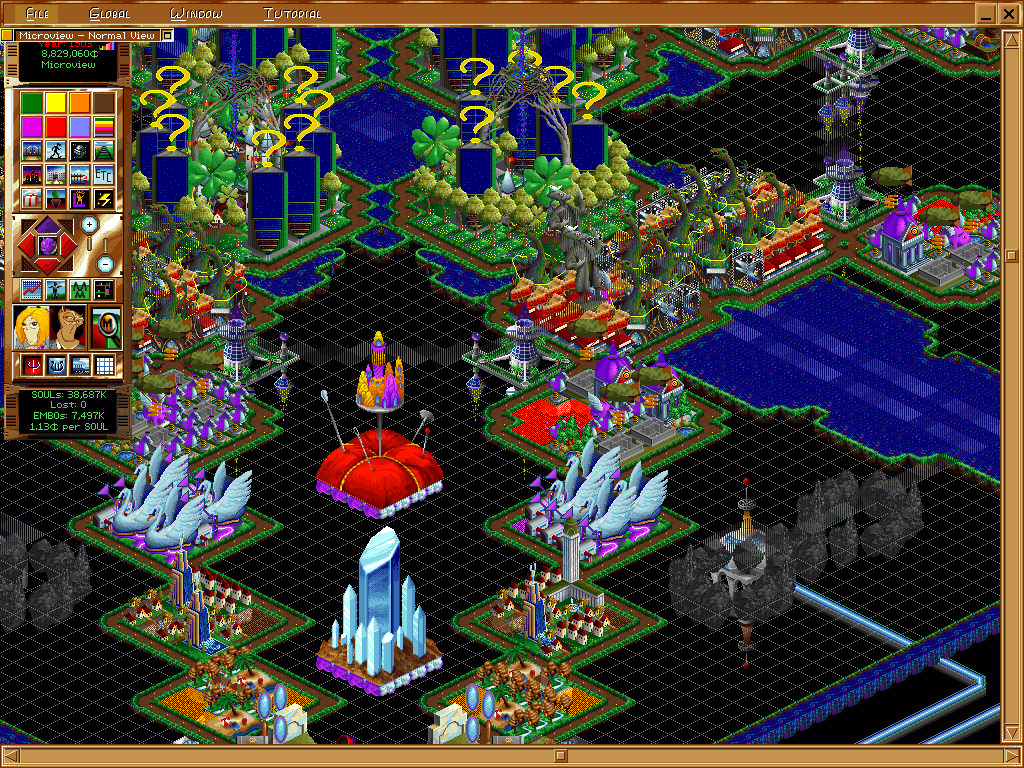Retro Replay Review
Gameplay
Afterlife offers a deeply strategic experience by blending the familiar city-builder mechanics of SimCity with a delightfully twisted “heaven versus hell” theme. Players simultaneously manage two parallel realms—one governed by virtues and the other by vices—each requiring careful zoning, resource allocation, and infrastructure planning. From laying out roads to determining which souls go where, every decision directly impacts your bottom line and the overall balance of cosmic karma.
(HEY YOU!! We hope you enjoy! We try not to run ads. So basically, this is a very expensive hobby running this site. Please consider joining us for updates, forums, and more. Network w/ us to make some cash or friends while retro gaming, and you can win some free retro games for posting. Okay, carry on 👍)
The soul economy in Afterlife is both intuitive and challenging. Souls arrive through gates based on their dominant sin or virtue, and they need to be directed to the appropriate processing facilities—whether that’s a cherub’s workshop doling out mercy or a demon’s furnace enforcing wrath. If you neglect to build streets or expand capacity, wandering souls will clog your domains and eventually return to the mortal plane, cutting into your revenue stream.
Managing personnel adds another strategic layer. You can hire experienced celestial or infernal workers, but training them in specialized facilities often yields better performance over time. Each building’s efficiency hinges on fine-tuning settings such as operating speed, energy consumption, and worker satisfaction—though an “auto-pilot” management tool is available for those willing to pay a premium.
To keep the economic wheels turning, you must also monitor power production, maintain soul happiness, and respond to random disasters like the infamous “Birds of Paradise,” which shower excrement across your heavenly gardens or hellish plazas. Whether you’re focusing on a free-play sandbox or tackling one of the five scenario challenges, Afterlife’s gameplay loop remains both engaging and refreshingly humorous.
Graphics
Visually, Afterlife strikes a charming balance between lighthearted whimsy and dark satire. The 2D isometric presentation offers clear, colorful sprites that make it easy to distinguish between virtues like Charity and sins like Greed. Each zone has its own distinct architectural motif—pearly white cathedrals for heaven, fiery obsidian for hell—lending strong visual identity to your dual realms.
Animation effects are used sparingly but effectively. Souls float from gate to zone on ethereal trails, workers scurry around buildings carrying tiny assets, and disasters like rain of droppings or invasive flamingos add a dash of comic relief. The UI overlays—such as happiness meters, energy gauges, and staffing tickers—are neatly integrated, ensuring you always know where to focus your attention.
While the game’s age shows in some lower-resolution textures, the overall art direction remains timeless. The humor shines through in the small details: grinning cherubs tossing coins, impish demons sharpening pitchforks, and cheeky tooltip messages that keep you smiling even as you juggle competing priorities.
Sound design complements the visuals with a light orchestral score for heaven and a more percussion-driven, ominous track for hell. Ambient effects—distant angelic choirs or the crackle of brimstone—immerse you further into your dual domains without ever feeling intrusive.
Story
Afterlife doesn’t rely on a linear narrative but crafts its storyline through emergent gameplay and scenario objectives. In free-play mode, your tale unfolds organically as you build up your afterlife empire, responding to cosmic events and market fluctuations. The game’s tongue-in-cheek premise—where the afterlife is run like a capitalist venture—provides a steady stream of amusing context for every strategic choice.
The five included scenarios each present a unique narrative challenge, such as rebuilding heaven after a divine budget cut or rescuing hell’s economy from a soul shortage. These scripted missions introduce memorable characters—overworked angelic accountants, power-hungry demon lords, and celestial bureaucrats—whose witty dialogues add depth and charm to your objectives.
Each scenario is bookended with playful cutscenes rendered in simple comic-strip style, reinforcing the game’s satirical tone. While there’s no epic hero’s journey, the dynamic interplay between virtues and vices, profits and punishments, crafts its own brand of storytelling that keeps you invested from gate one to gate infinity.
Overall Experience
Afterlife stands out as a uniquely humorous twist on the city-builder formula, offering both depth and accessibility. The dual-realm mechanic ensures you’re never bored—balancing the needs of virtuous souls against the appetites of damned spirits creates a constantly shifting strategic puzzle. The learning curve is gentle, but true mastery demands thoughtful micromanagement or judicious use of the auto-manager tool.
The game’s tone is consistently witty, from pun-laden building names to unexpected disasters that force you to adapt on the fly. While some veterans of the genre may find the graphics dated, the gameplay systems are robust and surprisingly rich, providing dozens of hours of engaging city-management fun.
Whether you’re drawn to the novelty of running a capitalist afterlife or you simply enjoy detailed resource-management sims, Afterlife delivers a memorable experience. It’s perfect for players who appreciate strategy with a generous dash of humor, and it remains an underrated classic for fans of the genre seeking something offbeat yet substantial.
In the end, Afterlife proves that even in the realm beyond, good business practices—and a wicked sense of humor—are the keys to eternal success.
 Retro Replay Retro Replay gaming reviews, news, emulation, geek stuff and more!
Retro Replay Retro Replay gaming reviews, news, emulation, geek stuff and more!









Reviews
There are no reviews yet.